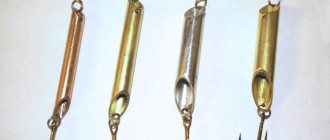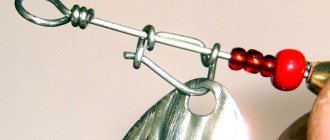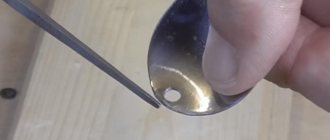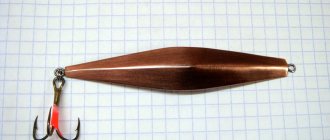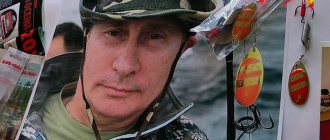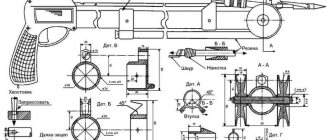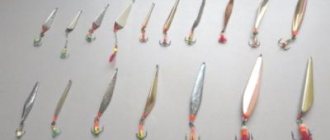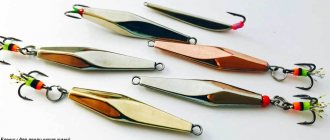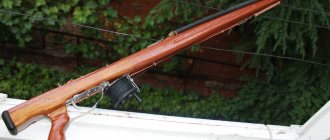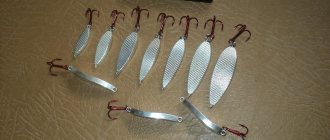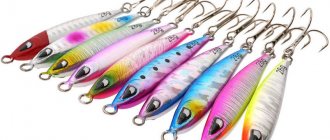Spinner hatchet
The hatchet spinner is a new product that is still not very common on Russian reservoirs. Now it is of considerable interest to both anglers and fish. The main object of fishing with this lure is perch. The first prototypes appeared in the Baltic states, Latvia and Estonia. These countries have quite a few reservoirs of large area, but shallow depth. It is in such reservoirs that perch, flocking in large schools, hunt using the driven method, forming so-called cauldrons. With high competition for food, success is achieved by the largest individuals, which are the desired prey of any angler. With high competition, the perch not only picks up the fish that is in its field of vision, but also actively moves in search of it, on occasion taking prey from weaker individuals. These principles of perch hunting are embedded in the spoon we are discussing.
Externally, the spinner looks quite simple; in cross-section it is a triangular, tapering piece of metal. Equipped with either a soldered hook or a hanging tee at its narrow end. There are several variants of this spoon: a classic triangle, a triangle with a bevel, a triangle with a specially shaped hydraulic wing. An important point is the hook, equipped with a fly. The perch bites precisely on the fly, and very rarely, on the spinner itself. When lifted, the hatchet makes very strong vibrations and vibrations; these are the vibrations that come from an actively feeding perch that has grabbed its prey. These movements are recorded by the lateral line of the perch at distances of up to 80 meters. This inflames the hunting instinct of the perch, stimulating it to first approach the place where the vibrations come from, and then start feeding. Fat herds of fatty perches, when they arrive at the place, do not find the object of feeding, but the nutrition program that its brain has already launched requires food. At this moment, the spinner is defined not as a spinner, but as a food competitor that has already caught prey, remember the hook with a fly, and, rising to the top, swallows it. At this moment, the perch is not thinking about how to find another food fish, but how to take prey from a competitor. Thus, this catchable winter lure works both as an attracting object and as a feeding one.
Kaliningrad and its region are also located in the Baltic states and our conditions are similar to Latvia, Estonia and Finland. Accordingly, the baits for fishing will be similar. The best place for hatchet fishing is the Curonian Lagoon. Record sizes, in 2001 a perch weighing 4.5 kilograms was caught in Kaliningrad and its huge quantity attracts not only local residents, but also fishing tourists from greater Russia. Almost every fishing trip comes across perch weighing 1-1.5 kilograms; this body of water can safely be called the main source of perch in Kaliningrad. February is the month when perch is most active, the approaching spawning requires active feeding, and the gastronomic qualities of this fish are most attractive at this time. Catches at this time of year can reach several tens of kilograms, especially if you fish with bait that is not yet familiar to the perch, such as a hatchet spoon.
In conclusion, I would like to say that now this lure in various weights and colors can be purchased directly in Kaliningrad, in the Profishing store.
See you again! Yours sincerely, Profishing 39.
We are located at: Kaliningrad region, village. Kutuzovo, st. Promyshlennaya, 1 (landmark - Trade and Service Park "Robinson"). Telephone
Profishing39 is engaged in wholesale and retail trade of all types of equipment for sport fishing, tourism and diving. Our store's assortment includes rods, reels, fishing lines and braids, wobblers and spinners, silicone baits, hooks, floats, landing nets and thousands of different fishing accessories and accessories from popular Japanese, European and domestic brands.
You can also purchase products for winter fishing.
In addition, Profishing39 is the official representative of the Jaxon brand. Today it is one of the largest companies in central Europe. All produced fishing gear undergoes many tests by a team of the best fishing experts.
Equipment selection criteria
In this case, this process should be taken a little more seriously than in other cases when it comes to the extraction of the striped robber. You will need to first acquire elements such as a carabiner, preferably with a clasp. Also, it would not be superfluous to have a triple swivel, as well as a leash and a reverse leash. Further, everything is according to the standard: rod, reel, fishing line, jig and the hatchet lure itself, where would we be without it.
In this case, it is better to use an inertial reel, and a regular telescopic rod. The jig is colorful, even bright. Line with a diameter of up to 0.25 milligrams.
DIY hatchet spinner.
- Veronika Gridina 2 years ago Views:
1 The technology for making the “hatchet” spinner is extremely simple. Precision in maintaining the size and configuration of the spoon is required. One day they brought me a silver ingot 70x25x8 mm and asked me to work a catchy “hatchet”. I sawed the metal strip into 1/12 pieces
2 diagonals, sanded off all the excess (leaving only what is indicated on the sketch) and got two catchy spoons, copies of one of them are still cast in our house. But let's do everything in order and specifically. 1. Now I am making a hatchet spoon from two or three metal plates with a total thickness of 7.5-8 mm. You need to understand that the configuration of the spinner is such that one side of it is almost flat, or more precisely, it has a recess (recess) of 0.5–0.7 mm. And this side consists of one type of metal, here I use silver about 1-2 mm thick. 2/12
Main characteristics of homemade bait
Unlike pike and pike perch baits of this type, homemade perch spoons have the following characteristics:
- Size – spinners for catching perch have a length from 20 to 40-60 mm.
- Weight – from 2.5 to 5-6 grams;
- The shape is oblong, imitating a small fish (perch, gudgeon, roach, sailor perch);
- Color – for winter fishing for perch, lures with a shiny silver and golden color are suitable;
- Type and method of fastening hooks. In perch baits of this type, both rigid and movable mounts are used for the hooks used. At the same time, spinners with rigidly fixed (soldered) hooks have a more stable game.
Also, perch baits of this type are most often equipped with single or double hooks. Tees are placed on such spoons in those reservoirs where trophy perch are caught.
Misconceptions when creating bait
When making winter perch spoons on their own, many beginners often have the following misconceptions:
- Possibility to use the made bait also in open water. Even the most catchy winter perch spoons are of little use for fishing in summer;
- Using one spoon for all reservoirs. The same bait can behave differently in different water bodies.
Also, beginners often think that the size of the spoon plays a role in its catchability. Like, the larger the spoon, the larger the fish it will take. This statement is true only when the predator is highly active. Usually during periods he is hungry for the first and last ice.
Adviсe
Before making a perch lure, it would be a good idea to listen to the following advice from experienced perch fishermen:
- To increase the attractiveness of a metal fish, multi-colored beads, woolen thread, and cambrics are placed on its double or by hooking a single hook;
- When equipping a metal fish, only sharp, high-quality hooks are used;
- After production, the imitation fry is checked in a barrel or aquarium filled with water;
- Using red waterproof varnish, an attack point is made on the body of the spinner - a small red eye that attracts a predator.
For the convenience of quickly replacing the spoon during fishing, a small clasp is attached to its upper winding ring
Non-snacking
You can also make non-hooking spinners from this kind of bait. Such gear can be used quite effectively in conditions of dense underwater vegetation, in snags and other hard-to-reach places. It is quite possible to buy a non-tackling spinner in a store, but their selection is not very large, which is why it can be difficult to find a working one, but the prices for them are not encouraging. For these reasons, many fishermen make such structures themselves.
In order to make a non-snagging bait, you must have:
- Any vibrator (you can use a previously made one).
- Single or double hook with straight shank.
- Soldering iron and solder or two rivets and a drill.
- A piece of thin, stiff steel wire.
To make bait you need:
- Insert the shank of the hook into the bottom hole of the spoon so that it is located along its back wall (sometimes it is necessary to slightly bend the tip of the spoon or drill out the hole).
- Solder the eye of the hook to the back wall of the spoon (you can drill a hole and use a rivet for reliability, since not every metal can be soldered well).
- Bend a small loop at the end of the wire.
- Bend it and cut it so that the loop lies on the back wall of the spoon, and the end touches the tip (or two, in the case of a double) of the hook.
- Solder the loop to the spinner (in this case you can also use a rivet).
DIY winter lures for perch
The most popular models of homemade winter perch lures are Gvozdik, Trubochka, Morpedka, Toporik, Bokoplav, Sleeper, Minskaya, Donnaya.
Carnation spinner
You can make a winter spinner of this type as follows:
- Two longitudinal cuts are made on a copper pipe clamped in a vice, cutting out a workpiece 20-25 mm long and 4-5 mm wide;
- Using a file, the workpiece is given the shape of a boat with a slightly narrowed lower part and a rounded upper part;
- Using pliers, the resulting petal is slightly bent at the bottom;
- The concave surface of the petal is degreased, soldering acid is applied and tinned with a thin layer of solder;
- The forend and half of the hook of the single hook are cleaned of the factory coating;
- The cleaned areas of the hook are treated with soldering acid and tinned;
- The hook is applied to the tinned inner surface of the petal and soldered at 2 points;
- The entire inner concave surface of the petal is filled with solder.
At the final stage, using coarse sandpaper, excess solder is removed from the body of the bait, and the outer part of its petal is sanded to a mirror shine.
tube
It is a simple, interesting imitation of a fry. They do it as follows:
- A piece of copper or brass tube is cut at two ends at angles of 45 and 60;
- Holes with a diameter of 3 mm are made near the tops of these corners;
- Winding rings are inserted into the drilled holes;
- A double hook is attached to the ring inserted into the hole at the top of the 45 0 angle;
- A small carabiner with a swivel is attached to the second winding ring.
The assembled spoon is cleaned with fine sandpaper and coated with transparent waterproof varnish.
Marine
This bait is made using the following technology:
- A piece of sheet copper or brass measuring 40×15 mm is bent in half;
- Using a template with sharp scissors, cut out the shape of a petal with the center of gravity shifted to the bottom of the petal;
- The folded petal blank is unbent using a thin knife and straightened on a metal corner;
- The inner surface of the petal is treated with soldering acid and tinned;
- Two rings are cut off from large hooks and soldered to the ends of the petal from the inside;
- The entire inner surface of the petal is gradually filled with POS-40 grade solder;
- Using a file and coarse sandpaper, remove excess solder;
- The outer surface of the petal is polished;
- A tee and a carabiner are attached to the loops in the tail and head of the spinner using winding rings.
Spinner hatchet
This rather weighty spinner is made as follows:
- Three blanks in the form of right triangles are cut out of three plates of different metals (nickel silver, copper and brass);
- Two plates are tinned on one side, and one on both sides;
- Having fixed the plate, tinned on both sides, between the other two, using a soldering iron or hair dryer, they are securely fastened together into a single piece;
- The long side of the workpiece in the upper part is sharpened on an emery machine;
- At the top of the corner between the two long sides of the triangular blank, a longitudinal cut is made, treated with soldering acid, tinned and a small hook is soldered;
- A small hole is made in the turned long side using a drill;
- By hanging the resulting hatchet on a small wire hook, check its balance. Lures for perch should hang horizontally. A slight roll can be eliminated by grinding off a certain amount of material.
- The place where the hook is attached to the body of the hatchet is covered with red paint.
Lures from improvised means
There are many options for making spinners from materials that are not intended for this at all, from spoons or beer caps to cuts of reinforcing bars. Fishermen make promising gear from everything that is at hand. It is worth considering the manufacture of spinners from various non-standard materials.
From coins
Using small fish as a bait body is another know-how from old-time fishermen. The simplest bait can be made from a coin by simply drilling two holes in it along the edges and attaching a hook through a winding ring. However, there is a more unusual way to create a spinner out of coins.
To make it you need:
- Select 3-4 coins of different sizes - from largest to smallest.
- Drill two holes opposite each other in the edges of each of them.
- Using winding rings, assemble them into a kind of snake. Usually the coins are arranged in descending order.
- Attach a tee to the smallest one. The largest one is a carbine.
There is a trick on how to make a noise spinner out of such a spinner. It is necessary to secure in one or several places not one coin, but two, folded together, through the same rings - when moving, they will hit each other, making noise.
From the tube
There is another spinner that is quite simple to make from whatever comes to hand. The material for its manufacture can be any shiny metal tube. Typically bronze, copper or aluminum is used for this, but steel options are also available.
To make a spinner from a tube you need:
- Cut a piece 70 millimeters long from a tube with a diameter of 8–10 millimeters.
- Saw off one edge at an angle of 70 degrees, and the second at 20.
- At the ends of the resulting workpiece, drill holes for the winding rings.
- Clean all sharp corners with a file and sandpaper.
- Attach a tee and a carabiner with a swivel.
You can make such a lure with your own hands in literally 15 minutes, however, if you want to change the bait’s play to a more measured one, while increasing its weight, the edges or the entire cavity inside can be filled with lead. In order to adjust the weight, lead or tungsten pellets can be placed inside, which will also create a noise effect after the holes at the edges are plugged.
To make this spinner we will need:
- Tin can (I use an empty air freshener can)
- Small carabiners.
- Scissors
- Awl
- Swivels
- Threesomes or doubles
- Wind-up rings.
- Sanding paper
Let's get to work. We put the data of our future spinner on paper, here are the dimensions
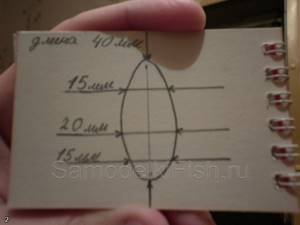
Next, open the cylinder, be careful and make sure that all the pressure is released from the cylinder.
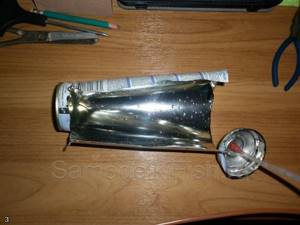
Now we transfer the dimensions to the inside of our material, mark it reliably and cut it out, I will cut out several blanks at once!
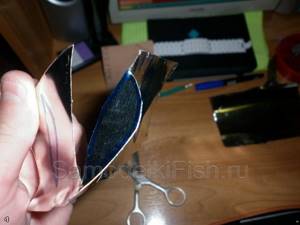
We clean the outer surface of production paint and try to achieve the effect of a glossy surface, we also clean the edges and sharp edges to the desired size!
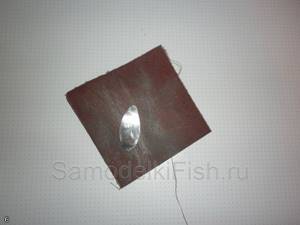
We make holes in our spoon with an awl at the right points and then bend it; I bend it using an ordinary kitchen rolling pin. The spinner bends only inward, from 2 to 4 millimeters
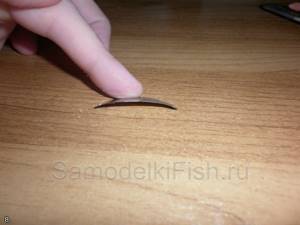
We put a winding ring on top and bottom and on the bottom ring we put a double or tee, I prefer doubles, because of the more familiar “game”.
Winter options
There are spinners designed, for the most part, for vertical fishing. Of course, this does not make them only winter baits, since they can be used quite successfully when fishing with wire, but their main advantage is vertical play.
Hatchet
This type of spoon is most often used in winter, but even in summer it can boast good catchability when fishing from a boat. However, to make it you need a set of tools, which not every angler has. So, to create a spinner you need:
- Three plates made of different metals: copper, brass and stainless steel, with a total thickness of 8 millimeters.
- Hook.
- Soldering iron and solder.
- Hacksaw.
- Electric emery.
- Drill.
To make a hatchet spinner, you need:
- Clean and solder three plates together.
- Saw them diagonally.
- According to the presented drawings, shape the workpiece using sandpaper.
- Using semicircular files, finalize the shape and make selections on the side edges.
- Make a cut in the sharp end and solder a hook there.
- Using electrical tape, center the spoon and drill a hole in the ground edge so that the hatchet is perfectly balanced.
- Adjust the balance using a file and polish the surfaces.
Cicada
This type of spinner can be effectively used both for spinning fishing and for vertical fishing. They are made in various shapes, so the easiest way would be to use the factory model you like as an example. To make a cicada spinner, you need:
- Trace the factory shape of the bait onto a copper plate.
- Cut the workpiece along the contour and sand it with sandpaper.
- Drill holes at the bottom for attaching hooks and at the top for a carabiner in the same way as on the original spoon.
- Polish or paint the workpiece.
- Thread winding rings and hooks into the holes.
Fishing rod for winter trolling
When fishing with such baits from ice, use a winter fishing rod for trolling. You can buy it in a store or make it yourself. It is very simple to make such tackle with your own hands. To do this you need:
- Grate the stopper for the handle.
- Coat a tube of a comfortable thickness with glue and roll it over the cork chips.
- Wait for it to dry and repeat step 2 until the desired thickness is achieved.
- Clean the surface with sandpaper.
- Seal the openings front and back with champagne corks.
- Secure a small reel to the handle using tie clamps or electrical tape.
- Drill a hole for the whip in the center of the front plug.
- As the latter, you can use the upper leg of a telescopic fishing rod or a feeder whip. We insert it into the hole and fix it with glue.
All that remains is to reel in the fishing line, and the winter fishing rod is ready.
Some features of equipping and playing with this bait when trolling
Now I’ll tell you about some small points, I often hide doubles and tees under a small tail of red threads (unraveling the fabric) or put pieces of artificial bloodworm on the bend of the fore-end (at your request). This creates a so-called “predator attack point.”
This lure turns out to be very light and I load it on a leash, no closer than 25 cm from the upper winding ring. In the water, it plays beautifully with small jerks up 7-10 cm and then releasing it and “planing” it down.
I use it in winter at depths of 2 to 5 meters; I’ve been making them personally for 3 years now and I’m very happy with the result. Happy fishing and good bite!
VAL1904 – Especially for the site Homemade FISH
Features of catching winter perch on the “Toporik”
Many experienced anglers with extensive experience definitely have the “Hatchet” spinner in their arsenal, because it shows excellent catching results not only for winter perch, but also when catching other predators.
To catch perch in winter under different conditions, different Hatchet lures are used; for example, when fishing for winter perch in currents, heavier versions of the Hatchet should be used, as well as when fishing at great depths. But for shallower water fishing, lighter “Hatchets” are suitable, which can also be used for fishing in still waters.
